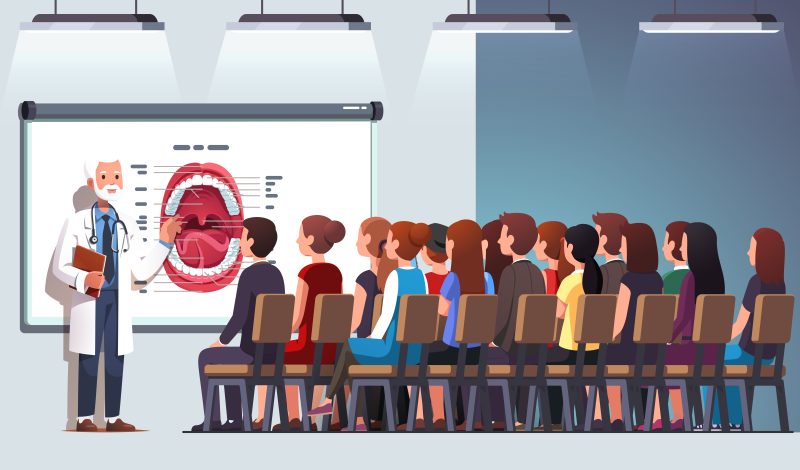Radiography and Radiation Protection in Dentistry – Information, Instruction and Training
Radiography is frequently used for diagnosis and treatment planning in dentistry and even though dental radiography delivers a very small radiation dose, there are still associated risks. Employers have a duty of care and a legal obligation, to minimise the risks arising from exposure to ionising radiation, to their employees, their patients and any other persons who may be affected.
One of the key ways to ensure exposure to ionising radiation is kept ALARP (As Low As Reasonably Practicable) is through Information, Instruction and Training.
Legal Responsibilities
The Employer is responsible for ensuring all staff involved in the production of images are trained appropriately for their role and are aware of the precautions that are required to be taken to restrict radiation exposure.
Under the Ionising Radiations Regulations 2017 (IRR17) the Employer must ensure employees are given appropriate radiation protection training. This includes all levels of training for staff who either work with ionising radiation or need to be given suitable information/instruction to avoid being unnecessarily exposed, i.e.: radiation awareness. Refresher training needs to be scheduled at regular intervals.
Under the Ionising Radiation (Medical Exposure) Regulations 2017 (IR(ME)R17) the Employer is required to be aware, and have records of, all levels of training for staff who act as practitioners and operators at the practice.
Employees who operate dental x-ray equipment
All staff, trained and qualified to take x-ray exposures must undertake training which includes:
- the health risks associated with dental x-ray exposures
- the precautions to be taken in accordance with the risk assessment, the local rules and the requirements of the contingency plans for their place of work
- the requirements of IRR17 in relation to dental radiography and the necessity of compliance with these regulations.
IR(ME)R Practitioners, Referrers and Operators
In addition, IR(ME)R practitioners, referrers or operators need to complete IR(ME)R training relevant to their role and specific area of practice (as set out in Schedule 3 of IR(ME)R).
The GDC recommends dentists and dental care professionals undertaking radiography must complete a minimum of five hours of verifiable CPD in radiography and radiation protection during each five-year CPD cycle. The radiation protection element of this CPD should cover:
- The principles of radiation physics
- Risks of ionising radiation
- Radiation doses in dental radiography
- Factors affecting doses in dental radiography
- The principles of radiation protection
- Statutory requirements
- Selection criteria (IRMER Practitioners)
- Quality assurance.
SGA have developed a ‘Radiography and Radiation Protection in Dentistry’ course which aims to provide dental radiographers with information pertaining to radiation protection and legislation and fulfils the above CPD requirements. The course can be found on our Online Learning Platform, which allows for on demand, flexible, online study.
Employees involved with CBCT imaging
Additional training is required before working with dental CBCT equipment for the first time, or before referring patients for dental CBCT examinations or clinically evaluating CBCT images. There are two levels of CBCT training:
Level 1 – Core Training
Level 2 – for CBCT Operators
Level 2 – Dental CBCT Justification and Image Interpretation
For employees involved in CBCT imaging it is recommended that at least one hour of the five hours of verifiable radiography CPD must be specific to dental CBCT.
Employees not directly involved with radiography
Staff whose radiography related duties are limited to processing films/ plates or the identification of patients etc, or non-clinical staff (administrative, cleaners etc), should be given sufficient information to enable them to undertake their roles safely. Training should include:
- Radiation awareness – it is a Health & Safety Executive requirement that all those involved in work, or affected by work, with ionising radiation are provided with suitable and proportionate information to avoid being unnecessarily exposed to ionising radiation.
- The significance of warning signs and lights, RPS details, restrictions relating to room access during radiography etc.
Such training can be carried out in-house during staff meetings, for example.
Employees of child-bearing potential
The Employer has a duty to inform pregnant employees of the possible risk arising from ionising radiation to the foetus, and of the importance of informing the Employer in writing as soon as possible after becoming aware of their pregnancy.
Carers and Comforters
Carers and comforters can only take part in an examination involving x-rays if they do so ‘knowingly’ and ‘willingly’ – ie they are made aware of the risks. This involves letting them know how their exposure will be restricted, how and where they must stand and where they must put their limbs in order to stay out of the primary beam.
Training Records
The Employer must retain information on all radiation related training undertaken by staff. This should include, but is not limited to:
- Radiation safety / awareness
- Formal training undertaken in line with IRR17 and IR(ME)R regulations
- In-house training, briefings or instruction that employees receive (such as addressing local rules, employer’s procedures requirements or contingency plans),
In summary, the provision of instruction, information and training on radiation protection is not only a statutory requirement for dental radiography it is also essential for promoting safe working practices and ensuring that exposure to ionising radiation is kept As Low As Reasonably Practicable.
For further information:



